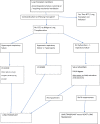Lung Transplant from ECMO: Current Results and Predictors of Post-transplant Mortality
- PMID: 33842193
- PMCID: PMC8021937
- DOI: 10.1007/s40472-021-00323-4
Lung Transplant from ECMO: Current Results and Predictors of Post-transplant Mortality
Abstract
Purpose of review: We examined data from the last 5 years describing extracorporeal life support (ECLS) as a bridge to lung transplantation. We assessed predictors of survival to transplantation and post-transplant mortality.
Recent findings: The number of lung transplants performed worldwide is increasing. This is accompanied by an increase in the type of patients being transplanted, including sicker patients with more advanced disease. Consequently, there is an increase in the need for bridging strategies, with varying success. Several predictors of failure have been identified. Major risk factors include retransplantation, other organ dysfunction, and deconditioning.
Summary: ECLS is a risky strategy but necessary for patients who would otherwise die if not bridged to transplantation. The presence of predictors for failure is not a contraindication for bridging. However, major risk factors should be approached cautiously. Other, more minor risk factors may be considered acceptable. More importantly, the strategy should be individualized for each patient to achieve the best possible outcomes.
Keywords: Bridge to transplant; Extracorporeal life support (ECLS); Extracorporeal membrane oxygenation (ECMO); Lung transplantation.
© The Author(s), under exclusive licence to Springer Nature Switzerland AG 2021.
Figures
References
-
- Chambers DC, Cherikh WS, O Harhay M. Hayes D, Hsich E, Khusch K, on behalf of the International Society for Heart and Lung Transplantation et al. The International Thoracic Organ Transplant Registry of the International Society for Heart and Lung Transplantation: Thirty-sixth adult lung and heart-lung transplantation Report-2019; Focus theme: Donor and recipient size match. J Heart Lung Transplant. 2019;38(10):1042–1055. doi: 10.1016/j.healun.2019.08.001. - DOI - PMC - PubMed
-
- Peek GJ, Mugford M, Tiruvoipati R, Wilson A, Allen E, Thalanany MM, Hibbert CL, Truesdale A, Clemens F, Cooper N, Firmin RK, Elbourne D. Efficacy and economic assessment of conventional ventilatory support versus extracorporeal membrane oxygenation for severe adult respiratory failure (CESAR): a multicentre randomised controlled trial. Lancet. 2009;374(9698):1351–1363. doi: 10.1016/S0140-6736(09)61069-2. - DOI - PubMed
-
- Davies A, Jones D, Bailey M, Beca J, Bellomo R, Blackwell N. on behalf of Australia and New Zealand Extracorporeal Membrane Oxygenation (ANZ ECMO) Influenza Investigators. Extracorporeal Membrane Oxygenation for 2009 Influenza A(H1N1) Acute Respiratory Distress Syndrome. JAMA. 2009;302(17):1888–1895. doi: 10.1001/jama.2009.1535. - DOI - PubMed
Publication types
LinkOut - more resources
Full Text Sources
Other Literature Sources
Research Materials

